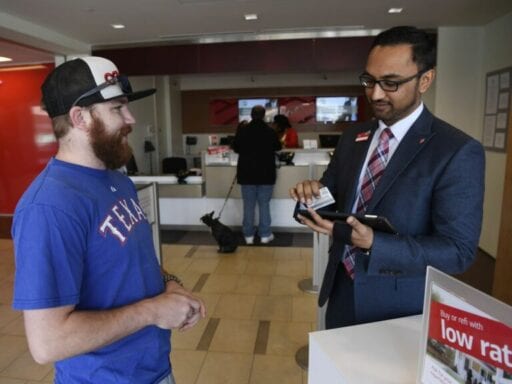Big banks are racing to open new branches, but workers are scarce.
America’s biggest banks are trying to outbid one another to hire new workers.
Bank of America announced Tuesday that it would raise starting pay for bank employees in the US to $20 an hour in the next two years, a huge jump from the current $15 hourly rate. The change will mostly benefit bank tellers and people who hold other low-paid positions within the company’s workforce of 200,000 employees. The first pay bump will happen on May 1, with minimum hourly pay rising to $17 an hour.
The move follows similar changes at competing US banks, which are adding new jobs for the first time in a decade. Bank of America said Tuesday that the raise was a way to thank employees for their hard work, and while this may be true, the reality is that banks need to raise wages to keep growing.
After years of budget cuts, Wall Street banks are now on a hiring spree, opening dozens of new branches across the country to reach new customers. But they are competing for the same small group of available workers during a national labor shortage. And the financial industry is having a harder time filling positions than most other sectors. In 2017, the finance and insurance industry was only able to fill half of all open positions —the worst outcome of all major industries, according to the Department of Labor.
Right now, low-skilled workers are in high demand, and these are exactly the type of workers Bank of America and JPMorgan Chase need to staff all the new branches they plan to open across the country. They have no choice but to raise wages. The question, though, is whether they’re offering enough to entice people to join the workforce.
Brick-and-mortar banks are making a comeback
Analysts have long warned of the end of bank branches, where customers show up to cash checks. They assumed the rise of online banking and the proliferation of ATMs would eventually put tellers out of work. That has not been the case, though — at least, not yet.
About 2.1 million people work at banks across the country, a number that hasn’t really changed in the past decade, according to data from the Federal Deposit Insurance Corporation. It’s true that banks have been closing hundreds of physical branches, but now they are also trying to open new ones in areas that have long been neglected (like predominantly black and Latino neighborhoods).
JPMorgan Chase, the largest US bank based on assets, is in the middle of a nationwide expansion, with plans to add up to 90 Chase branches in nine major cities. Most will open up in the Washington, DC, area, and about a third of those will be in low- to moderate-income communities. The bank expects to hire about 700 people in the capital region this year as part of that expansion.
In November, the bank promised to pay at least $18 to bank employees in the DC area after bumping minimum pay to $15 an hour for the overall workforce in January 2018. SunTrust and Comerica banks also boosted pay to $15 an hour last year, citing record profits from recent corporate tax cuts.
Bank of America is also trying to reach new markets. The company said last year that it planned to open 500 branches across the country, in areas such as Cleveland and Lexington, Kentucky. The bank says the expansion will add 5,500 jobs in local markets.
Banks are doing more than just raising wages. Last year, Bank of America expanded paid parental leave for employees from 12 weeks to 16 weeks, and the company didn’t raise health insurance premiums for workers who earn less than $50,000 per year.
All these new perks for the lowest-paid workers at America’s largest banks point to a broader trend in the US economy: Workers have more leverage than ever.
It’s a workers’ labor market
For the longest time, US companies could be picky about whom they hired. They didn’t have to try too hard to find workers because the number of people looking for work each month has been higher than the number of available jobs.
That changed last year.
For nearly a year now, the number of open jobs each month has been higher than the number of people looking for work — the first time that’s happened since the Department of Labor began tracking job turnover two decades ago.
At the end of January, the US economy had 7.6 million unfilled jobs, but only 6.5 million people were looking for work, according to data released in March. That was the 11th straight month that the number of job openings was higher than the number of job seekers. And each month, the gap has grown.
Employers have been complaining about a shortage of skilled workers in recent years, particularly workers with advanced degrees in STEM (science, technology, engineering, and math) fields. Nearly every industry now has a labor shortage, but here’s the twist: Employers are having a harder time filling blue-collar positions than professional positions that require a college education.
The hardest-to-find workers are no longer computer engineers. They are home health care aides, restaurant cooks, finance workers, and hotel staff. The shift is happening because more and more Americans are going to college and taking professional jobs, while working-class baby boomers are retiring en masse.
This means that for once, low-skilled workers have the most leverage in the current labor market. There’s no better time for workers to demand higher pay and better benefits. JPMorgan Chase knows that. Wells Fargo knows that. And Bank of America is betting that $20 an hour and extra paid parental leave will be enough to win over workers and entice them to stay.
Author: Alexia Fernández Campbell
Read More



